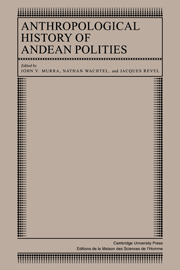Book contents
- Frontmatter
- Contents
- List of contributors
- Preface
- Introduction
- Part I Ecology and society
- Part II The ethnic group and the state
- Part III Systems of classification
- 8 Some aspects of the Inka kinship system
- 9 The classification and naming of South American camelids
- 10 The semiology of Andean textiles: the talegas of Isluga
- Part IV Symbolic representations and practices
- Part V From ethnic polities to communities
- Bibliography of published source
- Index
8 - Some aspects of the Inka kinship system
Published online by Cambridge University Press: 05 October 2010
- Frontmatter
- Contents
- List of contributors
- Preface
- Introduction
- Part I Ecology and society
- Part II The ethnic group and the state
- Part III Systems of classification
- 8 Some aspects of the Inka kinship system
- 9 The classification and naming of South American camelids
- 10 The semiology of Andean textiles: the talegas of Isluga
- Part IV Symbolic representations and practices
- Part V From ethnic polities to communities
- Bibliography of published source
- Index
Summary
Data on the meanings of Inka kinship terms during the late sixteenth and early seventeenth centuries are found in the following sources: the Arte and the Vocabulario of Domingo de Santo Tomás, printed in Valladolid, both in the year 1560; the anonymous Arte de la lengua general (attributed to Juan Martinez Ormaechea), printed in Seville first in 1586 and again in 1603, and then in Lima in 1604 and 1614; the Arte and the Vocabulario of Diego Gonzalez Holguin, printed in Lima in 1607 and 1608 respectively; the Arte of Diego de Torres Rubio, printed in Lima in 1619; and the Ritual formulario of Juan Pérez Bocanegra, printed in Lima in 1631. The amount of data provided by these sources is surprisingly large, and although the glosses of many particular items are ambiguous, many others are unexpectedly free of ambiguity because of the descriptive specifications that follow the initial glosses. And although at first glance some aspects of the data may seem self-contradictory, the sources appear to be sufficiently reliable so as to render inappropriate any hasty judgment that the apparent inconsistencies are the result of error. It would seem better to take the testimony of the period as we find it and try to construct a theory of the Inka kinship system that can accommodate what the sources indicate. A full presentation of such a theory, and its support by analysis of all of the available data, would require a monograph of some length.
- Type
- Chapter
- Information
- Anthropological History of Andean Polities , pp. 121 - 136Publisher: Cambridge University PressPrint publication year: 1986
- 11
- Cited by



